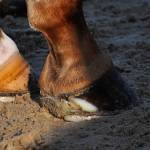Exploring New Surgical Options for Laminitic Horses

Laminitis typically occurs secondary to endocrine disorders, overconsumption of concentrates and sugar-rich grasses, and systemic infection, such as colitis and metritis.
Regardless of the inciting cause, inflammation of tissues within the hoof weakens the connection between the coffin bone (third phalanx or pedal bone) and the inner hoof wall. As a result, the weight of the horse causes sinking of the coffin bone to such an extent that the bone can actually penetrate the sole. Another sequela of laminitis involves rotation of the coffin bone due to the pull of the deep digital flexor tendon (DDFT) on the bone. In these cases, the coffin bone slowly rotates and ends up pointing toward the ground.
“While any bout of laminitis can be excruciating for the horse, sinking and rotation of the coffin bone take the pain to a new level and decreases the chances of the horse’s recovery,” explained Peter Huntington, B.V.Sc., director of nutrition at Kentucky Equine Research (Australia).
According to Canadian researchers from the Western College of Veterinary Medicine in Saskatchewan,* “there is no universally accepted treatment for the prevention of (coffin bone) rotation.”
One solution to rotation, as explained by the researchers, is to place a single 5.5 mm diameter medical-grade screw through the hoof wall and into the coffin bone. They estimated this tiny screw had sufficient holding power to counteract the forces of the DDFT in an average (1,100-lb or 500-kg) horse.
“If the anatomic integrity of the hoof could be maintained during the prodromal stages of laminitis, it is possible that complete recovery could occur,” indicated the researchers. Prodromal signifies the period between the appearance of initial symptoms and full development of disease.
In their pilot study exploring this approach to preventing rotation, the researchers found that healthy horses tolerated the screws well and did not become lame after placement. The screws appeared to have a stabilizing effect on the coffin bone.
“Much more research must be conducted prior to recommending this approach, but preliminary results appear promising,” shared Huntington.
He added, “Various means of preventing laminitis have been proffered, including the use of EO-3, a natural anti-inflammatory, or the hindgut buffer EquiShure, depending upon the cause of the laminitic episode. Once laminitis has been diagnosed and the prognosis positive, one nutritional recommendation is to feed Bio-Bloom PS (Bio-Bloom HF in Australia) to support hoof health and increase hoof growth to help return the hoof to normal function.”
*Carmalt, K.P., J.L. Carmalt, K. Henderson, et al. 2019. Novel technique for prevention of rotation of the distal phalanx relative to the hoof wall in horses with acute laminitis. American Journal of Veterinary Research 80(10):943-949.








